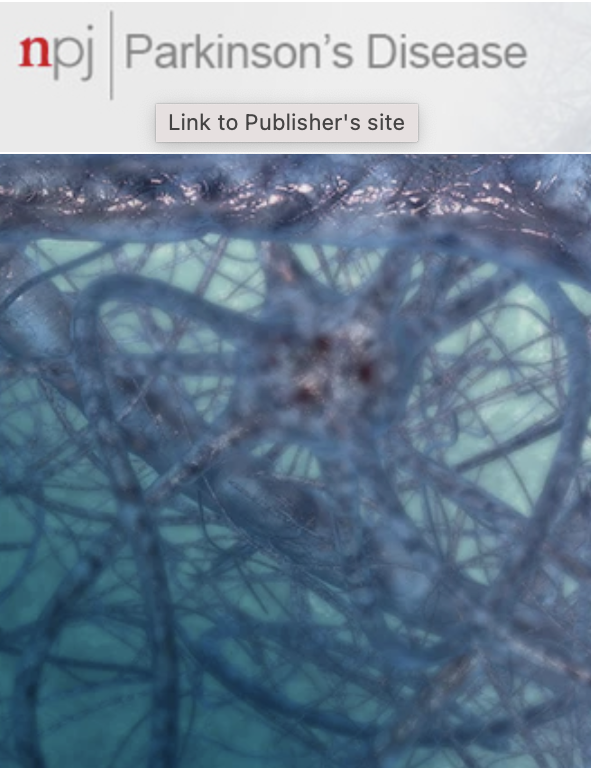Increased frontal [123I]FP-CIT binding in Parkinson's disease patients with self-reported REM sleep behavior disorder.
IF 8.2
1区 医学
Q1 NEUROSCIENCES
引用次数: 0
Abstract
Rapid eye movement (REM) sleep behavior disorder (RBD) is a frequent non-motor symptom of Parkinson's disease (PD) and a potential early marker of synucleinopathy-related neurodegeneration. While striatal dopaminergic dysfunction in PD-RBD has been extensively studied, the role of extrastriatal monoaminergic alterations -particularly those involving serotonin - remains poorly understood. In this study, 155 PD patients underwent [123I]FP-CIT SPECT imaging to assess striatal and extrastriatal tracer binding, reflecting dopaminergic and broader monoaminergic function, respectively. Probable RBD was identified using a validated single-question screening tool with high sensitivity and specificity. Patients with probable RBD (RBD + , n = 44) were compared to those without (RBD - , n = 111) using voxel-wise and region-of-interest analyses, controlling for age, sex, disease duration, motor and non-motor symptom severity, and cognitive function. No significant differences were observed in striatal dopamine transporter binding. However, RBD+ patients showed significantly higher extrastriatal binding in the prefrontal cortex (pFWE < 0.05), suggesting a potential role for altered extrastriatal monoaminergic neurotransmission, possibly involving serotonergic pathways, in PD-RBD pathophysiology. These findings should be interpreted with caution due to the non-selective binding profile of the radiotracer.帕金森病患者快速眼动睡眠行为障碍中前额叶FP-CIT结合增加[123]。
快速眼动(REM)睡眠行为障碍(RBD)是帕金森病(PD)常见的非运动症状,也是突触核蛋白病相关神经变性的潜在早期标志。虽然纹状体多巴胺能功能障碍在PD-RBD中已被广泛研究,但纹状体外单胺能改变的作用-特别是涉及血清素的改变-仍然知之甚少。在本研究中,155名PD患者接受了[123I]FP-CIT SPECT成像,以评估纹状体和纹状体外示踪剂结合,分别反映多巴胺能和更广泛的单胺能功能。使用经过验证的单问题筛选工具确定可能的RBD,具有高灵敏度和特异性。在控制年龄、性别、疾病持续时间、运动和非运动症状严重程度以及认知功能的情况下,采用体素分析和感兴趣区域分析,将可能患有RBD的患者(RBD +, n = 44)与没有RBD的患者(RBD -, n = 111)进行比较。纹状体多巴胺转运体结合无显著差异。然而,RBD+患者在前额皮质的纹外结合明显增加(pFWE < 0.05),表明纹外单胺能神经传递的改变可能涉及5 -羟色胺能通路,在PD-RBD病理生理中起潜在作用。由于放射性示踪剂的非选择性结合特征,这些发现应谨慎解释。
本文章由计算机程序翻译,如有差异,请以英文原文为准。
求助全文
约1分钟内获得全文
求助全文
来源期刊

NPJ Parkinson's Disease
Medicine-Neurology (clinical)
CiteScore
9.80
自引率
5.70%
发文量
156
审稿时长
11 weeks
期刊介绍:
npj Parkinson's Disease is a comprehensive open access journal that covers a wide range of research areas related to Parkinson's disease. It publishes original studies in basic science, translational research, and clinical investigations. The journal is dedicated to advancing our understanding of Parkinson's disease by exploring various aspects such as anatomy, etiology, genetics, cellular and molecular physiology, neurophysiology, epidemiology, and therapeutic development. By providing free and immediate access to the scientific and Parkinson's disease community, npj Parkinson's Disease promotes collaboration and knowledge sharing among researchers and healthcare professionals.
 求助内容:
求助内容: 应助结果提醒方式:
应助结果提醒方式:


